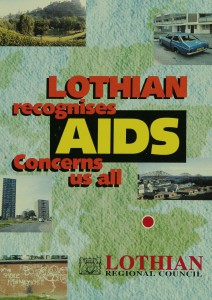HIV/AIDS in Edinburgh and the Lothians, 1983 – 2010
Edinburgh’s first case of HIV was diagnosed in 1983. As the decade went on, the city’s high infection rate(nearly seven times the national average) meant that our region was at the forefront of the battle against the spread of the virus.
At first, there was some uncertainty about how the virus could be transmitted – so with the passing of time, treatment and prevention initiatives focussed on different ways that HIV could spread. Early efforts concentrated on transmission through homosexual sex, but the focus was soon widened as it was realised that the virus could also be spread by transfusion of contaminated blood, sharing needles to inject drugs and heterosexual sex.

The scale of infection in Edinburgh meant that a major response was needed from a range of groups. Different bodies worked together to fight the spread of HIV and AIDS, including Lothian Health Board, local government, police, charities, voluntary groups and campaign organisations. They worked to identify people who were HIV positive so that appropriate treatment and care could be provided and infection prevention plans put in place. At the same time, ground-breaking public awareness campaigns educated the public on how they could (and could not) be at risk.
The most effective of these initiatives was the ‘Take Care’ campaign, launched in 1989 jointly by the Lothian Health Board and Lothian Regional Council. Where campaigns in the wider UK used negative images (such as tombstones), ‘Take Care’ broke with the past with its frank and fun approach, telling people how they could ‘take care of the one you love’ through making the right choices and recognising when they could be at risk from HIV and AIDS. ‘Take Care’ spread the message that HIV and AIDS could affect anyone and its main focus was sexual transmission of the disease. As the ‘Take Care’ campaign progressed into the 1990s, needle exchange services, antenatal screening, blood testing and contact tracing evolved as further ways to prevent people being at risk from HIV.
Edinburgh’s early collaborative approach to fighting HIV and AIDS makes the city stand out in national public health policies, and Lothian Health Services Archive holds unique materials that reflect how this history played out from a range of different points of view.
Timeline
Early 1980s
First concerns about the spread of HIV and AIDS come from the USA medical community.
1983
First suspected cases of HIV in Edinburgh, and new evidence suggests that HIV could be transferred though blood.
1984
First medical group responds to HIV and AIDS in Edinburgh: the Lothian AIDS Advisory Group (LAAG), was set up to advise Lothian Health Board (LHB).
1985
Dr John Peutherer, virologist and member of LAAG, discovers that intravenous drug users had high rates of HTLV-III antibodies. HTLV-III was an early name for the virus that can lead to AIDS, it is now known as HIV
1986
Ground-breaking official report published by the Scottish Committee, known as the McClelland Report, investigates the link between HIV infection and drug misuse. The Report produced some of the first official recommendations for needle exchanges – issuing syringes and needles on a one-for-one exchange basis to drug users as a means of epidemic control. In response, LHB set up the Lothian Regional AIDS Team to co-ordinate action from local government, charities, the police, and health organisations against the AIDS epidemic. Dr George Bath is appointed leader.
1987 – 1988
Between June 1987 and June 1988, reported cases of HIV infection in Edinburgh increased from 1239 to 1504. Of these figures about half were due to intravenous drug use; a quarter to homosexual sex; and the final quarter to contaminated blood products and other routes of transmission. By far the greatest of these other routes was heterosexual sex. [1]
1987
The Taylor Report is commissioned by the Scottish Home and Health Department, which made around 50 recommendations in the fight to prevent the spread of HIV and AIDS. It drew much of its evidence from Edinburgh’s experience and initiatives with respect to the care and treatment of HIV and AIDS suffers. This local policy response in Edinburgh went on to influence national policy decisions in Scotland.
1988
Cases of HIV and AIDS in Edinburgh and the Lothians are calculated as seven times the national average.
1989
LHB’s ‘Take Care’ campaign launched. The frank and vibrant campaign aimed to educate the public on how HIV could be contracted and ways to prevent being infected using the message ‘take care of the one you love’. The campaign also involved a broad base of organisations of widely varying types so that the message of safe sex and health education could be promoted amongst teachers, youth workers, church workers, employers and the entertainment industry to reach as wide an audience as possible.
1989
Scottish charity Waverley Care is founded in Edinburgh to provide services that responded to the changing needs of people living with HIV in Scotland. The charity went on to develop the UK’s first purpose build hospice to provide end of life care for those with HIV, Waverley Care Milestone. This transformed into an intensive residential support unit and a community support service for people living with HIV or Hepatitis C.
1995
More than 25,000 people in the UK are now living with HIV. A new class of HIV drugs is made available, paving the way for effective treatment.
Footnote 1
High levels of intravenous drug use can be identified as a main contributor to the spread of HIV in Edinburgh. In comparison with the rest of the UK, few cases of HIV in Edinburgh were attributed to homosexual transmission. HIV spread most rapidly amongst the capital’s drug-using population regardless of their sexual orientation. However, drug abuse was a national problem so why were Edinburgh’s intravenous drug users particularly vulnerable to HIV transmission in comparison with the rest of the UK?
- Sudden shortage of cannabis made many users experiment with harder drugs such as heroin.
- Increased popularity of cheap heroin flooded the UK market via the east coast of Scotland. Injection increased as a method of taking the drug.
- Taking the drug intravenously added to the frequency of sharing injecting equipment as it was difficult to obtain sterile needles and syringes.
- Lothian and Borders police took a tough approach to drugs. Drug paraphernalia was seized – needles or syringes could be confiscated even without drug possession, but this in turn increased the use of sharing equipment.
- Sharing injection equipment was a widespread practice amongst drug users, the majority of whom were sexually active. This in turn was a contributing factor to bridging HIV into the wider non-drug using population.

